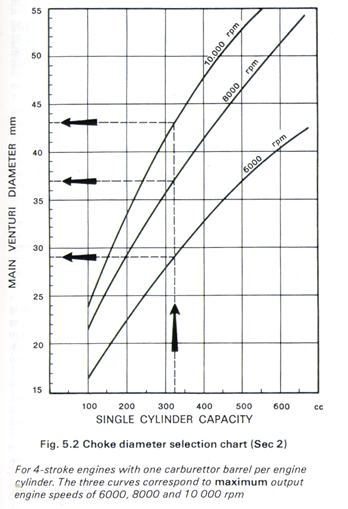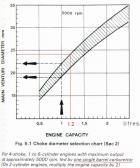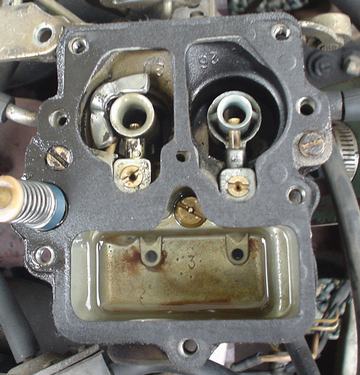Proper carburetor sizing is important for good performance. For maximum power, consult the carburetor manufacturer's recommendations. For good power and great street flexibility, choose a slightly smaller size. Flexibility means smooth action at all RPM ranges and throttle openings (off-idle, part throttle and full throttle).
Contents |
General Sizing Guidelines
For a stock A12 engine (max 69 bhp at 6000 RPM), choose:
- Dual 2-choke carbs (ITB): 28mm venturis
- Progessive carb: 20/26 mm venturis
- Single-bore carburetor: 33mm venturi
The carburetor size -- and more specifically, the venturi (choke) size -- is dependent on the type of inlet manifold being used. A plenum manifold flows differently than a non-plenum setup like ITBs.
Or course for a modified A12 engine with higher RPM range than stock, say for 6,000-8,000 rpm max power, you'd want bigger venturis.
Remember that the theoretical size is just a starting point. Actual test driving or dyno runs will show if slightly bigger or smaller is desired. It depends on what you want: more peak HP at the expense of partial throttle response and low-speed operation, or the reverse. Note the the charts will indicate a range of size (the shaded area), but you could go outside that if you wanted to enhance flat-out acceleration and don't care about off-idle performance (example: fitting a DGV Weber 32/36 to a stock A12).
Invidual Runners
- 4 cylinders, 4 carb bores
For a single carburetor barrel (bore) per cylinder, rather than multiple carbs or bore feeding all cylinder via a plenum, use this chart:
So for our stocker A12 engine (max power at 6000 RPM), choose 28mm venturis.
Another way to look at it is maximum horsepower.
For a 4-cylinder engine:
36mm venturis: 180 bhp 34mm venturis: 160 bhp 32mm venturis: 140 bhp 30mm venturis: 120 bhp
Bore Size: 40s or 45s?
What size Weber DCOE carburetors can use a 28mm venturi?
The choke size will be within the limits of 0.7 to 0.9 of the barrel diameter which is measured at the throttle valve end of the carburetor
So per this rule we can theoretically fit chokes (venturis):
- Weber "40" (40mm bore) can fit chokes of 29mm to 36mm
- Weber "45" (45mm bore) can fit chokes of 32mm to 40mm
Conclusions:
- 6000-RPM A12: dual 40s are a bit large, but in reality seem to work OK if you fit the smallest venturis.
- 8000 RPM A12, calling for 36mm venturis per the chart, you could use either 40s or 45s.
- You can fit 45s to a relatively stock A12. It will run "OK", but is not optimal. You'll actually make more power with correctly tuned 40s.
With stock A12 and dual-carburetors (one barrel per engine cylinder) 28mm venturis are called for. In A12 practice that means 27mm for totally stock engine for maximum flexibility or 29mm for maximum power with little less flexibility. Flexibility means good response at all RPMs with no flat spots or rough transitions no matter what the throttle opening (part-throttle or full-throttle).
Plenum Manifold
From this chart from the weber book, we see discern what sizes to use. For a 1200cc engine at 6000 rpm it looks like a 26mm secondary venturi is called for, based on this chart and interpolating for 6000 rpm. Looking at Nissan's A12 specs, it seems Nissan used the same logic:
- A12 secondary venturi: 26 mm
- A12 "theoretical" main: 24mm (per chart)
- A12 actual main venturi: 20mm
IMPORTANT: This chart is for "single" carburretor feeding all the cylinders (i.e. using a plenum).
According to the fine text below this chart:
- It doesn't matter if it's a 1-cylinder, 2-cylinder, 4-cylinder or 6-cylinder engine, Weber recommends to use the same size carburetor.
- "2-cylinder" wording in the chart has been questioned, and may be a typo. Did they mean "two-cycle"?
Single Sidedraft
A typical single-sidedraft setup has a single barrel feeding two cylinders, with no plenum. Times 2.
Progressive Carburetor
The usual goal of a progressive carburetors is to give better low speed flexibility. The primary and secondarys will be matched on synchronized carbs like the Weber DGAS 38/38 -- but on a progressive type you have a smaller primary. All Hitachi DCG306/DCH306 have barrel sizes of:
- 26/30
But more importantly, what about choke (venturi) sizes? According to the Nissan factory books:
- The A12 (and A12A) got venturis of 20/26.
- Most A14s are 23/27, but some were 22/27.
- A15s mostly use the 22/27, but Canadian A15s had 23/27.
- (By comparison, Weber DGV is 26/27)
So the A-series Hitachis have much smaller barrels than the Weber 32/36 Carburetor. However the Weber venturis are not that much larger than the Hitachi A14 venturis.
You can look at the size of you carb, the numbers appear as is this photo. You can shine a flashlight down the air cleaner to see them:
This quotes helps to explain why Nissan give a small primary venturi (20mm) to our A12 engine:
the difference between the primary and secondary choke diameters may need to be increased 1 mm or 2 mm in order to give more flexibility at the lower engine speeds.
20mm is a lot smaller than the book recommends, but then our road-going Datsun 1200 has extremely good "flexibility at the lower engine speeds". It seems Nissan went to more an extreme, probably for flexibility and fuel economy, they used a much smaller primary venturi.
the secondary choke [venturi] size can be determined from Fig. 5.1 and the primary choke size is normally 1 mm less.
This is exactly what the Weber 32/36 does with its 26/27 venturis.
TIP: Since most A14 carbs have venturis of 23/27, that might give a nice performance boost for a stock A12, without sacrificing driveability. However, A14 carbs are generally a little leaner than early A12 carburetors.
Weber DGV: 26/27 venturis. Total area: 1103 A14 typical Hitachi: 23/27. Total area: 988
equivalent area to a single-bore carburetor:
Weber 32/36: 37mm Hitachi A14: 35mm Hitachi A12: 33mm
Weber 32/36
Weber says this carburetor is appropriate for engines of 1200cc to 2300cc, and their jetting good for all bone-stock engines of this size.
Hitachi 306
DCH306/DCG306 was available in different venturi sizes:
- A12 size 20/26 venturis, max bhp 70 @ 6000 RPM
- A14 sized 23/27 venturis, 80 bhp
- as much airflow as the Holley carburetor for Ford 2.3 engine
- good for a 6400 RPM A12
- A15 has 22/27 venturis, 80 bhp
- The best carb for a stock A12? Just needs some jet changes to richen it up
Hitachi 340
More airflow than a Weber 32/36, and smoother operation too.
VENTURI SIZES - TOTAL AREA Weber 32/36: 26/27 - 1103 DCH340 L18 : 23/30 - 1122 DCH340 L20B: 24/31 - 1208
See main article: Hitachi DCH340

![[Datsun 1200 encyclopedia]](/wiki/upload/wiki.png)





